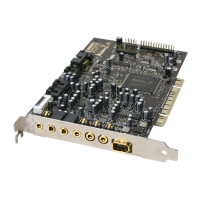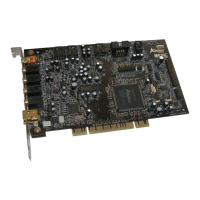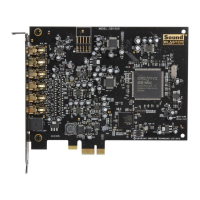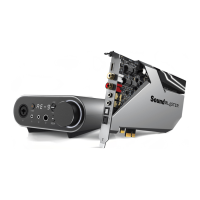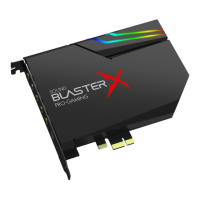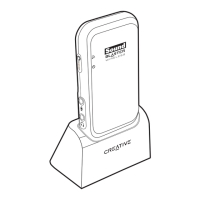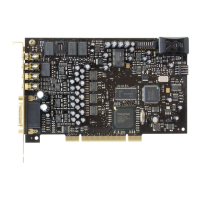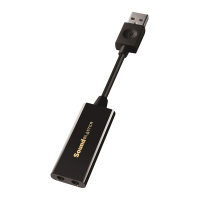Do you have a question about the Creative Sound Blaster Audigy 2 ZS and is the answer not in the manual?
Details the software package included with the Audigy 2 ZS Video Editor for creating movies and slideshows.
Lists the recommended computer hardware specifications for optimal video capturing and editing performance.
Provides essential tips for preparing your system, including defragmentation and driver updates, before starting video projects.
Explains the impact of processor speed and RAM on editing responsiveness and preview performance during video capture.
Details the storage needs for video projects, including raw footage, temporary files, and media storage for optimal performance.
Discusses compatible DVD writer types and media formats required for burning video projects successfully.
Highlights the importance of USB 2.0 for data transfer speed and guides on checking its presence and driver status.
Mentions the use of Windows XP for its USB 2.0 support and improved media functionality in video editing.
Specifies that graphics cards need DirectX compatibility but not necessarily 3D performance for video applications.
Ensures proper connection and power-up of the video source and Audigy 2 ZS Video Editor before capturing.
Guides users to launch DVD MovieFactory, select a new project, and choose the capture option for video devices.
Explains how to select capture formats, modes, and advanced settings for optimal video capture.
Details how to configure speaker settings and adjust audio effects like CMSS-3D for accurate monitoring.
Covers starting video playback, initiating capture, and stopping the process, including tips for preview and color adjustments.
Outlines the initial steps to prepare DVD MovieFactory for the Direct to Disc function.
Details the process of selecting the output format and drive to perform direct video capture and burning.
Details the initial steps to launch VideoStudio 8 and prepare for creating WMV files.
Explains how to load a video file into VideoStudio and prepare it for conversion to WMV format.
Describes the process of capturing video directly from a source and configuring it specifically for the Zen Portable Media Center.
Discusses DVD capacity, media types, and planning video size to fit within the available space.
Explains how DVD MovieFactory displays remaining space and how to check individual video file sizes.
Details how to structure a DVD with multiple titles and chapters for easy navigation and playback.
Compares capturing in MPEG versus DV/AVI formats, considering quality, editing, and hardware encoding benefits.
Highlights the advantages of DV capture (higher quality) and disadvantages (more space, no hardware MPEG encoding).
Explains when to capture in MPEG, emphasizing its efficiency for minimal editing and its advantage with analog sources.
Details how to control video and audio bitrates, CBR vs VBR, and their impact on quality and file size.
Explains how to set specific video and audio parameters like resolution, bitrate, and TV system for capture.
Discusses how project settings dictate video/audio format for rendering and the importance of planning ahead.
Explains how to modify MPEG settings during the rendering phase to fit more material or adjust quality.
Guides users on choosing the appropriate physical media type and logical DVD format for their projects.
Details various DVD formats like DVD-Video and DVD-VR, explaining their compatibility and features.
Describes connecting a TV or monitor to the audio/video outputs to monitor capture and preview operations.
Compares TV display characteristics to computer displays, highlighting differences in color, pixel blending, and overscan.
Details the different modes for monitoring audio, including syncing to PC or TV, and available audio output signals.
Explains DoMiNoFX as award-winning video processing technology for crisp, smooth MPEG encoding with minimal computer overhead.
Describes PerfectView Pro as an advanced MPEG compression technology designed to avoid digital artifacts and maintain detail.
Explains Motion Compensated Temporal Filtering (MCTF) for reducing noise in video sources, improving quality and recording time.
Introduces consumer digital video formats based on analog standards like NTSC and PAL, and their compression into DV or MPEG.
Details the characteristics of NTSC, PAL, and SECAM television systems, including scan lines, frame rates, and aspect ratios.
Explains composite and S-Video transmission, their connectors, and how they carry video and audio signals.
Describes how analog signals are converted to digital, compressed into DV or MPEG, and their respective characteristics.
Details the DV-25 (AVI) format, its compression techniques, resolutions, and its use in capturing video for DVDs.
Explains DV Type 2, which separates video and audio streams, enhancing compatibility with video software applications.
Describes MPEG1, its lower visual quality for action scenes, and its use in Video CDs (VCD).
Details MPEG2 for DVD and SVCD, its higher bitrates, improved encoding, and variable bitrate control.
Explains digital audio formats like PCM, MPEG Audio, and Dolby Digital, and their compression for DVD compatibility.
Presents parameter values for VCD, MPEG1, SVCD, DVD, and MPEG2 output formats, detailing resolutions and bitrates.
Explains DVD-Video, DVD-Audio, and DVD-ROM formats, and details the bit depth, sampling rate, and compressed bit rates for audio.
Describes DVD-VR and DVD+VR logical formats designed for on-disc authoring and editing with consumer DVD recorders.
Covers issues like hearing audio echoes during video capture and potential causes and solutions.
Addresses audio issues during WMV capture, voice recording problems, and USB device recognition issues.
Provides precautions for connecting DV cables, updating drivers, and troubleshooting USB 1.1 limitations and display differences.
| Audio Channels | 7.1 |
|---|---|
| Sample Rate | 192 kHz |
| Bit Depth | 24-bit |
| Signal-to-Noise Ratio (SNR) | 108 dB |
| Connectivity | PCI |
| THD + N | 0.004% |
| Chipset | EMU10K2 |
| Total Harmonic Distortion + Noise (THD+N) | 0.004% |
| EAX Support | EAX 4.0 |
| ASIO Support | Yes |
| MIDI Support | Yes |
| Headphone Amplifier | Yes |
| Digital Output | Optical |
